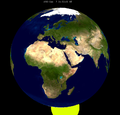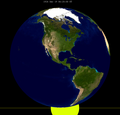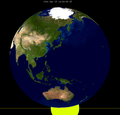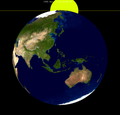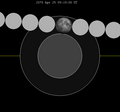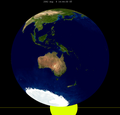Top Qs
Timeline
Chat
Perspective
Total penumbral lunar eclipse
Type of lunar eclipse From Wikipedia, the free encyclopedia
Remove ads
A total penumbral lunar eclipse is a lunar eclipse that occurs when the Moon becomes completely immersed in the penumbral cone of the Earth without touching the umbra.[1]

The path for the Moon to pass within the penumbra and outside the umbra is very narrow. It can only happen on the Earth's northern or southern penumbral edges. In addition, the size of the penumbra is sometimes too small where the Moon enters it to contain the Moon. The width of the Earth's penumbra is determined by the Sun's angular diameter at the time of the eclipse, and the Moon's angular diameter is larger than the Sun over part of its elliptical orbit, depending on whether the eclipse occurs at the nearest (perigee) or farthest point (apogee) in its orbit around the Earth. The majority of the time, the size of the Moon and the size of the Earth's penumbra where the Moon crosses it mean that most eclipses will not be total penumbral in nature.
Remove ads
Frequency
Summarize
Perspective
Total penumbral eclipses constitute a relatively small fraction of lunar eclipses, and the distribution of these events is uneven, occurring between 0 and 9 times per century. The period of this variation is approximately 600 years and also correlates with the frequency of total umbral eclipses and tetrads.[1]
The maximum number in Fred's 5K canon[N 1] is eight for saros 19.[2] Saros 32 and 132 have seven.[3][4] Saros 58, 95, and 114 have six.[5][6][7]
Saros 114 is the only saros in the canon to have a total of seven total penumbral lunar eclipses that are not all in a row.[7] Likewise, saros 169 has five total penumbral eclipses, but only four of them occur consecutively.[8]
Saros series with multiple consecutive total penumbral eclipses
This table summarizes which saros series contain four or more consecutive total penumbral eclipses.
Remove ads
Summary frequency of total penumbral, total umbral and tetrad events 501–2500

Remove ads
List of total penumbral lunar eclipse events 1901–2200
See also
Notes
- Total penumbral lunar eclipses are indicated by the Nx eclipse type in Fred Espenak's Lunar Eclipse canon.
- Saros 114 has seven total penumbral eclipses, but only six of them occur consecutively.
- Saros 169 has five total penumbral eclipses, but only four of them occur consecutively.
References
Wikiwand - on
Seamless Wikipedia browsing. On steroids.
Remove ads



